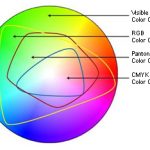Like any industry, printing and graphics have developed its own special language meant to keep outsiders away. In this article, I will reveal the secret terminology that, if you study hard, will allow you to pass as someone who knows something about the trade. Heck, it worked for me. Here we go:
CMYK – Perhaps the most ubiquitous term in printing and graphic, CMYK stands for Cyan, Magenta, Yellow and Black. Wait, whut? you might rightfully quizzle? Why “K” and not “B” for Black? There are competing theories for the development of this term and both hold a logic that makes good sense. Some say the “K” stands for “key colour”, since on a printing press, each ink is in its own printing unit with all other inks registering or “keying” (get it?) to Black. The other idea is that the letter K is used to avoid confusion with B for Blue, Brown or some other ink that starts with “B”. “K” is the exclusive designation in printing technology for black ink that’s used in four-colour process printing.
LPI, DPI, Pixels, Dots – Oh, my, what big picas you have. I’ve heard non-printers refer to the dots seen in offset printing as pixels. This sort-of makes sense in the way that the dots on a computer display are similar to printed dots in that they represent tone or colour to the human viewing the art. Except that printed dots are much smaller, are not in RGB (video display dots always are), are not in fixed positions in a grid (like on a video monitor) and don’t change the perceived colour by varying intensity of three dots (which is how RGB monitors work). Since there’s no such thing as an RGB printing press, the dots on an offset printed piece vary in size to show more or less of a particular colour, usually arranged in a pattern called a rosette for four-colour printing.
RGB – Red, Green, Blue. These are the colours of the video rainbow. There is no such thing as an RGB press. RGB is a colour mode that is used for digital images that display on a colour monitor or video display device. RGB has a much larger gamut than CMYK, so colours can appear richer and more saturated when viewed in this mode.
Gamut – This is the range of colours that can be reproduced in a given colour systems. CMYK can reproduce about 65% of the Pantone 1000. Add OGV (Orange-Green-Violet) inks and that number goes up to about 90%. So, gamut is the range of reproduction of a given colour system.
Contone – Short for continuous tone, this is a reproduction or display method that has no dots, like in offset printing, where all steps from 100% colour to no colour are fully reproduced without interruption. Most contract proofs today are contone proofs.
Contract Proof – This is a colour-accurate, controlled output proof that a print buyer can view under controlled lighting conditions that can be used as a “target” for printing. The proof represents the ability of the target printing system to reproduce the proofed work.
Don’t worry – there’s lots and lots of wonderful jargon to learn! Catch ’em all and someone may mistake you for a pro. Which you are. Of course.




